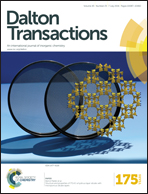Germylenes and stannylenes stabilized within N2PE rings (E = Ge or Sn): combined experimental and theoretical study†
Abstract
The deprotonation of aminophosphanes PhP(NHR)2 (R = t-Bu or Dip; Dip = 2,6-i-Pr2C6H3) and t-BuP(NHDip)2 using n-BuLi gave, depending on the stoichiometry, both the dilithium compounds {[PhP(Nt-Bu)2]Li2}2 (1), [PhP(Nt-Bu)(NDip)]Li2·(Et2O) (3), [t-BuP(NDip)2]Li2·(Et2O)2 (5) and [t-BuP(NDip)2]Li2·(tmeda)2 (5a), and the monolithium compounds [PhP(NHt-Bu)(NR)]Li·(tmeda) (R = t-Bu 2, Dip 4) and [t-BuP(NHDip)(NDip)]Li·(tmeda) (6). Treatment of 1, 3 and 5 with GeCl2·dioxane or SnCl2 in a 1 : 1 stoichiometric ratio gave the corresponding tetrylenes [PhP(Nt-Bu)2]E (E = Ge 7, Sn 10), [PhP(Nt-Bu)(NDip)]Ge (8) and [t-BuP(NDip)2]E (E = Ge 9, Sn 11). The heteroleptic germylene [Ph(H)P(Nt-Bu)2]GeCl (12) was obtained by the reaction of the monolithium compound [PhP(NHt-Bu)(Nt-Bu)]Li·(tmeda) (2) with GeCl2·dioxane in a 1 : 1 stoichiometric ratio, as a result of a spontaneous NH → PH tautomeric shift in the ligand backbone. In contrast, an analogous reaction with SnCl2 produced only stannylene 10 along with the PhP(NHt-Bu)2 starting material, suggesting scrambling of the ligands rather than a NH → PH tautomeric shift. Finally, heating 5a in solution led to P–C bond cleavage and formation of the bis(imino)phosphide [DipNPNDip]Li·(tmeda) (13). The reaction of 13 with GeCl2·dioxane, SnCl2 or PbCl2 in a 2 : 1 stoichiometric ratio yielded the unprecedented tetrylenes [DipNPNDip]2E (E = Ge 14, Sn 15 and Pb 16), in which the tetrylene center is incorporated within two N2PE rings. Treatment of the monolithium compound 2 with n-BuLi and K (or KC8) gave [t-BuNPNt-Bu]Li·(tmeda) (17) and{[t-BuNPNt-Bu]K(tmeda)}2 (18), respectively. In contrast to the reaction with 13, similar reactions of 17 with GeCl2·dioxane and SnCl2 resulted in the known compounds cis-[P(μ-Nt-Bu)2P(t-BuN)2]E (E = Ge, Sn); evidently the t-Bu groups do not provide sufficient steric shielding to protect the bis(imino)phosphide backbone as in the case of 14–16. The bonding situation in a set of selected compounds (8, 12–16) has been subjected to a theoretical survey with particular emphasis on the nature of the bonding between the ligand and the central metal and the bonding within the NPN core of the ligand, showing significant differences among the studied complexes.


 Please wait while we load your content...
Please wait while we load your content...